We may not have the course you’re looking for. If you enquire or give us a call on 01344203999 and speak to our training experts, we may still be able to help with your training requirements.
Training Outcomes Within Your Budget!
We ensure quality, budget-alignment, and timely delivery by our expert instructors.
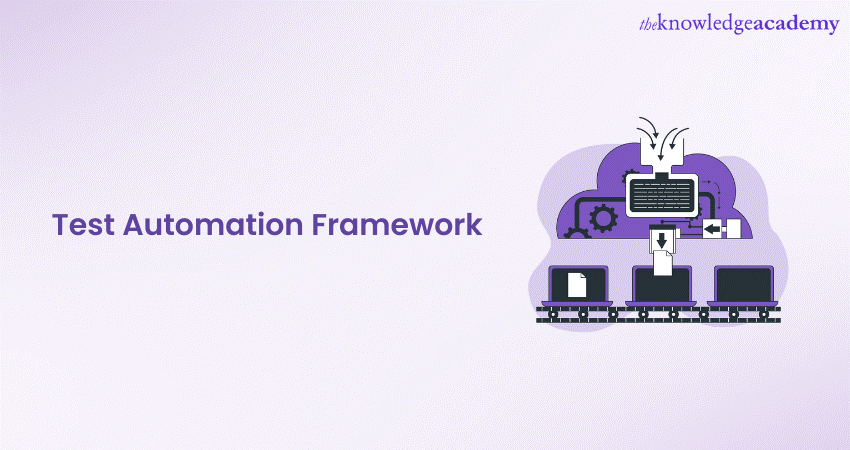
A Test Automation Framework is a structured and organised platform that provides guidelines, reusable components, and best practices for creating, executing, and managing Automated Test cases. In Software Development, delivering high-quality applications within tight timelines has become a paramount concern. This is why Test Automation has emerged as a crucial strategy to ensure software reliability and efficiency while accelerating development. At the heart of successful Test Automation lies a Test Automation Framework. Software testing ensures the reliability and efficiency of the developed software.
So, if you are a budding Software Developer looking to understand how Automation Tests work, you have come to the right place. This blog will look in-depth at Test Automation Framework, covering aspects like its types, advantages, and key components. Read more to find out!
Table of Contents
1) What is Test Automation Framework
2) Importance of Test Automation Frameworks
3) Advantages of using Test Automation Frameworks
4) Why do we need Test Automation Frameworks?
5) Key components of a Test Automation Framework
6) Types of Test Automation Frameworks
7) Best practices for Test Automation Framework development
8) Challenges and solutions in Test Automation Frameworks
9) Which Testing Framework is best?
10) Conclusion
What is Test Automation Framework
There is not one but many Test Automation Frameworks, providing structure, efficiency, and scalability to the Testing process. It is a structured set of guidelines, practices, and tools that facilitate Automated Test cases' design, implementation, and maintenance. It offers a standardised approach to creating and executing Tests, ensuring consistency, reusability, and maintainability across the testing lifecycle. Let us explore the key aspects of this framework in detail:
a) Structural blueprint: A framework provides a blueprint for organising Test cases, specifying how they should be structured, named, and grouped. This structural consistency aids in better Test maintenance and collaboration among team members.
b) Reusability: Frameworks encourage the creation of reusable components such as functions, libraries, and modules. This reusability significantly reduces redundancy and effort, making test case development more efficient.
c) Abstraction: Testers can focus on Test case logic and high-level scenarios without delving into technical implementation details. The framework abstracts complex technical aspects, simplifying the testing process.

Importance of Test Automation Frameworks
The significance of Test Automation Frameworks lies in their ability to streamline the Testing process, enhance collaboration, and ensure the reliability of Automated Tests. Here's why this framework becomes important:
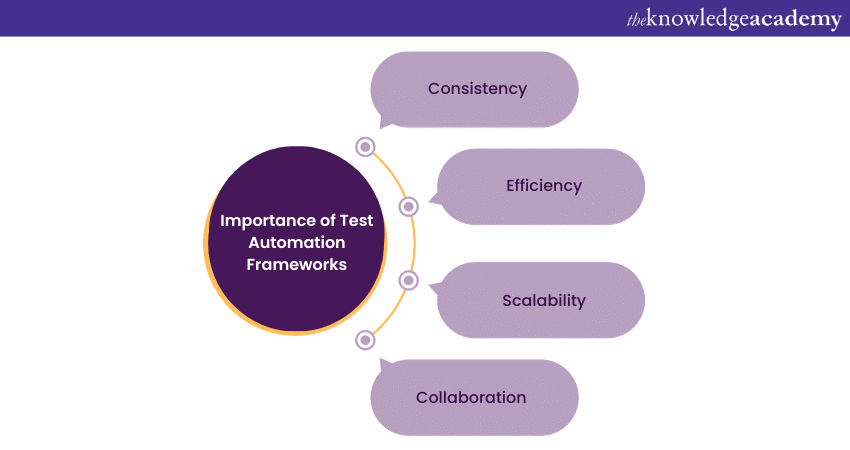
a) Consistency: Frameworks enforce consistent practices across all tests, ensuring the testing process meets defined standards. This consistency becomes critical when multiple team members are involved in test creation.
b) Efficiency: With predefined components and structures, frameworks accelerate test case development. Testers can build upon existing modules and functions, reducing the time required to create new tests.
c) Scalability: Maintaining a structured testing approach becomes essential as projects grow in complexity. Frameworks provide a scalable architecture that accommodates increasing test cases and scenarios.
d) Collaboration: Frameworks are a common platform for testers, developers, and stakeholders to collaborate effectively. They offer a shared understanding of test objectives, processes, and results, fostering better communication.
Advantages of using Test Automation Frameworks
Employing a Test Automation Framework yields various advantages contributing to more efficient and effective Testing practices. Let ushave a look at some of these advantages:
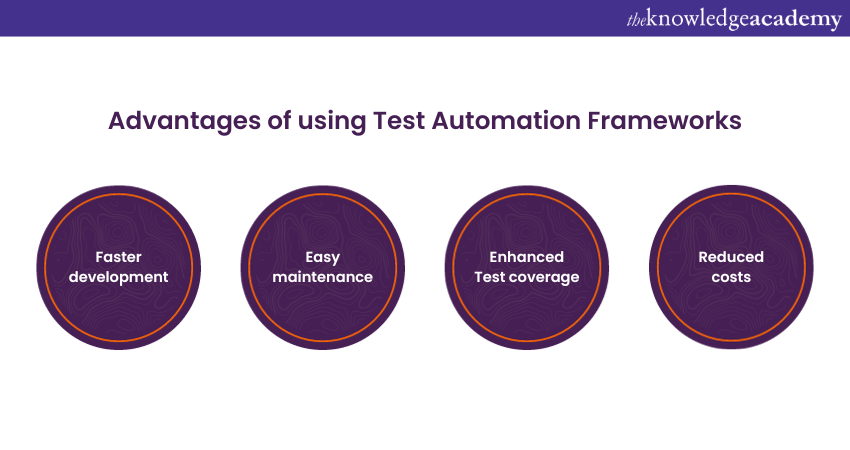
a) Faster development: Frameworks offer a repository of reusable components, such as functions, libraries, and templates. Testers can leverage these components to assemble test cases, reducing development time quickly.
b) Easy maintenance: Changes in the application or testing requirements can be accommodated swiftly by updating the central components of the framework. This ensures that modifications propagate to all related test cases, minimising maintenance effort.
c) Enhanced test coverage: Frameworks facilitate the creation of diverse test scenarios and data combinations. This leads to comprehensive test coverage. This ensures that various aspects of the application are thoroughly tested.
d) Reduced costs: Efficient testing through frameworks results in identifying defects earlier in the development cycle. This prevents issues from progressing to later stages of production, reducing the overall cost of fixing defects.
Learn one of the most highly demanded skills worldwide, sign up for our Automation & Penetration Testing Training now!
Why do we need a Test Automation Framework?
The world is progressing towards automation, resulting in an escalating demand for Test Automation. Properly planning and implementing Test Automation Frameworks offer following advantages:
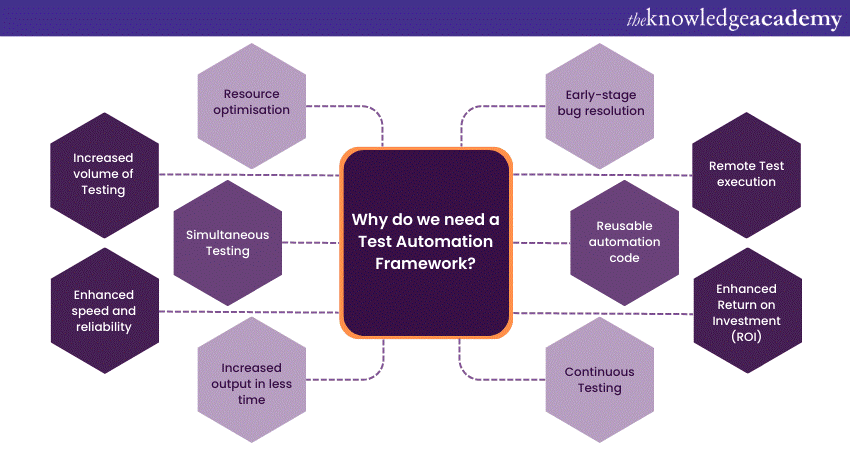
Resource optimisation
A Test framework facilitates resource optimisation by aligning different resources with the specific needs of an organisation. To accomplish established objectives, Test Automation Frameworks provide a series of processes that match resources with requirements. The greater the adaptability of adoption, the more effective the resource optimisation becomes.
Increased volume of Testing
Test Automation Frameworks significantly boost the volume of Testing. Consider the constant emergence of new mobile devices; Manual Testing for each one is impractical and time-consuming. However, Automated Testing empowers Testers to conduct Tests on a multitude of mobile devices simultaneously.
Simultaneous Testing
Test Automation Frameworks enable concurrent Testing on various device types. When Test scripts are automated, Testers merely need to execute them on different devices. Since the Testing parameters remain consistent, Testers can quickly generate comparative Test reports.
Enhanced speed and reliability
The process of writing and running Tests can be quite time-consuming for any software company. Test Automation Frameworks streamline these activities.
For example, when Testing a website's logout functionality, Manual Testing would require examining the functionality for multiple scenarios one at a time. However, using a framework allows simultaneous execution of all scenarios, delivering Test results in a fraction of the time. Automated Testing is more dependable due to the utilisation of automated tools, reducing errors.
Increased output in less time
Test Automation diminishes challenges related to synchronisation, local configurations, error management, and report generation. An automation script minimises the time required to prepare and execute Tests. With heightened efficiency and speed, organisations can achieve greater output in significantly less time.
Early-stage bug resolution
Utilising a Test Automation Framework is instrumental in identifying and addressing bugs at the early stages of development. This approach minimises the need for a substantial workforce, resulting in reduced working hours and expenses. Test Automation Engineers can script and Automate Tests.
By harnessing the appropriate Test Automation Frameworks, an organisation can implement the concept of "shift-left Testing," which emphasises moving Testing to the earliest phases of the Software Development lifecycle. This entails creating Automated Tests before even writing production code, aligning with methodologies like Test-Driven Development (TDD) and Behaviour-Driven Development (BDD).
Remote Test execution
A Test Automation Framework eliminates the need for constant physical presence in the office. You can initiate a Test and then leave the premises. Upon returning after a few hours, the Test results will be readily available. It is optional to acquire an extensive array of devices since Remote Testing is feasible.
Reusable automation code
Test Automation scripts can be repurposed in different applications. For instance, if your organisation's Testers have created scripts to Test the login functionality, those same scripts can be employed in another application with a similar login feature.
Enhanced Return on Investment (ROI)
Although the initial investment in Test Automation Frameworks can appear daunting, the long-term return on investment is high. These frameworks save time, expedite delivery, and reduce the need for additional staff.
A company can forgo hiring multiple Testers if Testing is automated. A Test Automation Engineer can handle various tasks, such as configuring the framework and executing scripts.
Continuous Testing
The significance of Continuous Integration and Continuous Delivery/Deployment (CI/CD) cannot be overstated. Establishing a fully automated software pipeline is the most reliable means of ensuring swift code deployment to production.
Expand your skills as an Automation engineer with our ISTQB Advanced Test Automation Engineer Course today!
Key Components of Test Automation Framework
Test Automation Frameworks are the backbone of efficient and systematic automated Testing processes. They provide a structured and organised approach to designing, executing, and maintaining automated Test cases.
These frameworks consist of various key components that work together to ensure consistency, reusability, and ease of maintenance. So, let’s explore the essential components that constitute a robust Test Automation Framework and understand their roles in achieving successful Automated Testing:
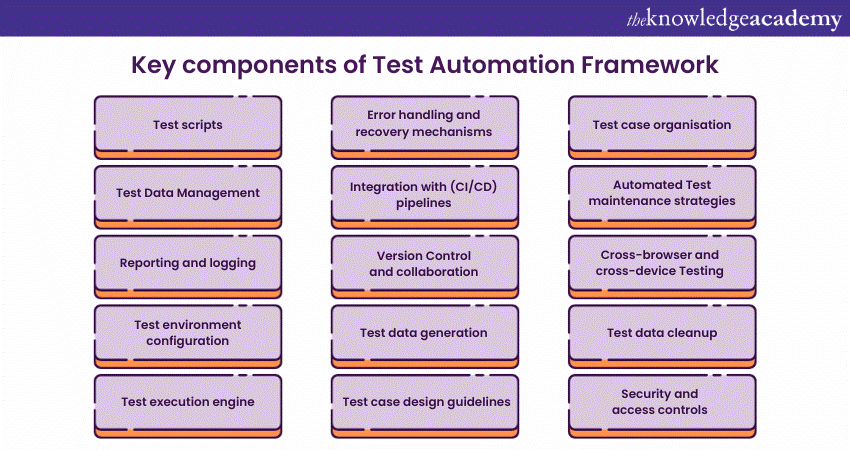
Test scripts
At the heart of any Test Automation Framework are the Test scripts. These scripts contain instructions that simulate user interactions with the application and verify its behaviour. Well-structured and organised scripts contribute to maintainability and readability. As a result, they enable Testers to understand the purpose and functionality of each Test case quickly.
Test Data Management
Effective Test Data Management is crucial for executing a variety of Test scenarios. The Test Automation Framework should provide mechanisms to handle different types of Test Data, such as valid, invalid, edge cases, and boundary values. Centralising and managing Test data ensures consistency and minimises errors during Test execution.
Reporting and logging
Clear and comprehensive reporting is essential for tracking the progress and results of Automated Tests. The Test Automation Framework should generate detailed reports that provide insights into Test execution status, pass/fail outcomes, and any deviations from expected behaviour. Logging mechanisms help diagnose issues and provide a trail of executed actions and corresponding outcomes.
Test environment configuration
A well-configured Test environment is crucial for reliable Test execution. The Test Automation Framework should facilitate the setup and configuration of Test environments to mimic production conditions as closely as possible. This includes managing databases, server configurations, and network settings.
Test execution engine
The Test execution engine is responsible for orchestrating the execution of Test cases. It should provide functionalities for parallel execution, Test scheduling, and result collection. An efficient execution engine contributes to faster Test cycles and efficient resource utilisation.
Error handling and recovery mechanisms
Automated Tests are susceptible to failures due to various reasons, such as application changes or intermittent network issues. A robust Test Automation Framework should incorporate error handling and recovery mechanisms to handle failures gracefully, continue test execution, and provide relevant diagnostic information.
Integration with Continuous Integration/Continuous Deployment (CI/CD) pipelines
Integrating the framework with CI/CD pipelines ensures seamless Test Automation within the Software Development lifecycle. Automated Tests should be triggered automatically upon code changes, providing quick feedback to developers. They should also prevent defects from progressing to production.
Version Control and collaboration
Maintaining Version Control for Test scripts and related assets is crucial for collaboration among team members. A Version Control system ensures that changes are tracked, conflicts are resolved, and a history of modifications is maintained.
Test data generation
Creating Test data using programs can be beneficial in specific situations, particularly when managing extensive datasets or complicated scenarios. A framework should provide mechanisms for generating realistic and diverse Test data to validate different aspects of the application.
Test case design guidelines
Standardised Test case design guidelines ensure consistency in Test script structure, naming conventions, and usage of best practices. Clear guidelines help streamline the Test creation process and make it easier for team members to contribute.
Test case organisation
Organising Test cases into logical groups or modules enhances maintainability and reusability. The framework should provide a structure for categorising and managing Test cases, making it easier to locate, update, and reuse them.
Automated Test maintenance strategies
Test scripts require maintenance as the application evolves. The framework should incorporate strategies for efficiently updating scripts to accommodate application changes while minimising disruptions to the overall Test suite.
Cross-browser and cross-device Testing
To guarantee that applications are compatible, the Test Automation Framework must be able to conduct Tests on various browsers and devices. This involves managing configuration settings and ensuring consistent behaviour across various platforms.
Test data cleanup
After Test execution, the framework should include mechanisms for cleaning up Test data to ensure a clean slate for subsequent Test runs. Proper data cleanup prevents interference between Test cases and maintains the integrity of Test results.
Security and access controls
For enterprise-level applications, security and access controls become critical. The framework should incorporate mechanisms to handle user authentication, role-based access, and secure storage of sensitive data used in tests.
The components mentioned above collectively form the foundation of a well-structured and efficient Test Automation Framework. Every component guarantees that the framework functions effectively to create dependable and consistent test outcomes.
Take the next step in your Software Testing journey with our Manual Testing Training course to gain the knowledge and skills you need for success. Sign up today!
Types of Test Automation Frameworks
Test Automation Frameworks are the bedrock upon which efficient and effective Automated Testing is built in the dynamic world of Software Development and Testing. Different types of Test Automation Frameworks cater to diverse project requirements, team expertise, and application complexities. So, let's explore some of its various types:
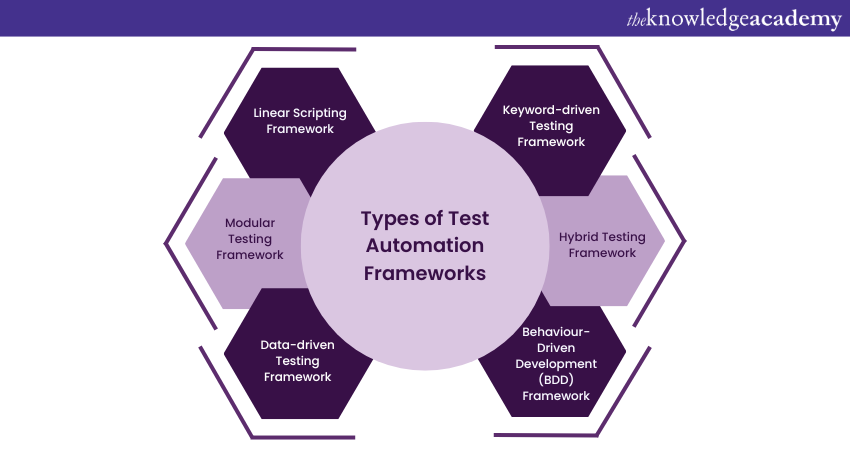
Linear Scripting Framework
The Linear Scripting Framework, also known as the Record and Playback Framework, is a basic form of automation where Testers manually interact with the application. At the same time, a recording tool captures these actions and generates corresponding scripts. This approach is simple and quick to set up, making it suitable for small-scale projects or early stages of automation. Let's explore some of its advantages and limitations:
|
Advantages |
Limitations |
|
a) Requires minimal technical knowledge b) Low entry barrier c) Immediate feedback on application behaviour |
a) Highly dependent on UI structure b) Difficult to handle dynamic elements c) Scripts require frequent updates to match UI changes |
Modular Testing Framework
The Modular Testing Framework organises Test cases into reusable modules or functions, each focusing on a specific application feature. This approach enhances reusability and maintainability, making it well-suited for medium to large projects. Let's explore some of its advantages and limitations:
|
Advantages |
Limitations |
|
a) Avoids duplication by reusing modules in different Test cases b) Changes in a specific module affect only related Test cases c) Modules can be added or modified as the application grows |
a) Designing a modular structure requires upfront planning b) Difficult to handle dependencies |
Data-driven Testing Framework
The Data-driven Testing Framework decouples Test scripts from Test Data, allowing the same script to execute with multiple input data sets. This approach is highly efficient for Testing various scenarios using a single Test script. Let's explore some of its advantages and limitations:
|
Advantages |
Limitations |
|
a) One Test script can cover multiple data combinations b) New scenarios can be added by adding new Test data c) A single script can be used for multiple iterations |
a) Poor Data Management b) Difficult to handle complex data structures |
Keyword-driven Testing Framework
The Keyword-driven Testing Framework involves creating Tests using predefined keywords that represent specific actions or interactions. These keywords are interpreted by the automation tool to execute corresponding actions, making Test cases readable and easily understandable. Let's explore some of its advantages and limitations:
|
Advantages |
Limitations |
|
a) Test cases are expressed in plain language by keywords b) Easy collaboration with non-technical team members using keywords c )Encourages reusability and modular design |
a) Requires initial efforts to maintain keyword library b) Increased complexity with an increased number of keywords |
Hybrid Testing Framework
This Test Automation Testing Framework combines elements of multiple framework types to address their respective strengths and weaknesses. It aims to leverage the benefits of different approaches to create a comprehensive and adaptable solution. Let's explore some of its advantages and limitations:
|
Advantages |
Limitations |
|
a) Suitable for multiple application scenarios and complexities b) Harnesses the advantages of different frameworks to create an optimal Testing solution |
a) Requires careful planning and integration b) Increased complexity with increased elements from multiple frameworks |
Behaviour-Driven Development (BDD) Framework
The Behaviour-driven Development (BDD) Framework emphasises collaboration between technical and non-technical team members. Tests are written in a natural language format, closely mirroring the application's expected behaviour. Let's explore some of its advantages and limitations:
|
Advantages |
Limitations |
|
a) Tests are written in plain language b) Test scenarios closely match business expectations c) Tests are living documentation |
a) Stakeholders require learning BDD syntax and concepts b) Tests might be slower than other frameworks |
Selecting the appropriate Test Automation Framework type is an essential decision that hinges on project requirements, team expertise, and long-term maintenance goals. Each framework type offers a unique approach to solving Testing challenges, and the choice should be based on careful consideration of these factors.
Gain in-depth knowledge on managing Test Automation by signing up for our Fundamentals Of Test Automation Training now!
Best practices for Test Automation Framework development
Developing a robust and effective Test Automation Framework requires careful planning, consideration, and adherence to best practices. A well-structured framework accelerates the Testing process and ensures the reliability and maintainability of automated Test cases. So, let’s explore key best practices for Test Automation Framework development that can significantly enhance the quality and efficiency of your Automated Testing efforts:
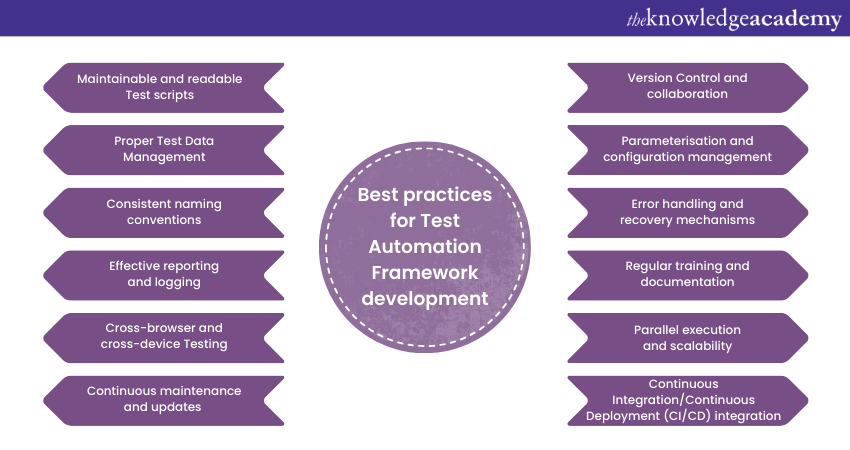
Maintainable and readable Test scripts
Here's how to develop maintainable and readable Test scripts:
a) Use descriptive names: Name your Test scripts, functions, and variables descriptively to clearly convey their purpose and functionality.
b) Structured code: Organise your code into logical sections and use indentation to improve readability.
c) Comments: Include comments to explain complex logic, assumptions, and key decisions in your scripts.
d) Avoid magic numbers: Replace magic numbers with meaningful constants or variables to improve script understanding.
Proper Test Data Management
Here's how to properly manage the Test data:
a) Separate Test data: Keep Test data separate from Test scripts to promote reusability and maintainability.
b) Centralised data storage: Store Test data in external files or databases for easy management and updates.
c) Use Data generators: Implement data generators to Test data, especially for large datasets programmatically.
Consistent naming conventions
Here's how you can maintain consistency while naming conventions:
a) Standardise naming: Define consistent naming conventions for test cases, functions, variables, and files.
b) Follow industry practices: Adhere to industry-standard naming conventions for better collaboration and code consistency.
Effective reporting and logging
Here's how you can ensure effective reporting and logging:
a) Comprehensive reports: Generate detailed reports that include Test execution status, passed and failed cases, and error details.
b) Logging levels: Implement logging with different verbosity levels to facilitate troubleshooting and debugging.
Cross-browser and cross-device Testing
Here's how you to conduct cross-browser and cross-device testing:
a) Parameterisation: Implement parameterisation for browser and device configurations to allow Testing across various environments.
b) Use browser drivers: Utilise browser drivers or libraries to manage different browser types and versions.
Continuous maintenance and updates
Here's how you can ensure continuous maintenance and updates of your scripts:
a) Regular reviews: Regularly review and update your Test scripts to ensure they are aligned with the latest application changes.
b) Scheduled cleanup: Include routines to remove obsolete Test cases, unused functions, and outdated data.
Version Control and Collaboration
Here's how you can ensure alignment with Version Control systems and collaboration:
a) Utilise Version Control: Store your Test scripts and related assets in a Version Control system to track changes and manage collaboration.
b) Branching strategy: Implement a branching strategy to manage parallel development efforts and prevent conflicts.
Parameterisation and configuration management
Here's how to manage parameterisation and configuration:
a) Externalise configuration: Store configuration settings separately from Test scripts for easy modification without altering code.
b) Use configuration files: Utilise configuration files to manage environment-specific settings, URLs, database connections, etc.
Error handling and recovery mechanisms
Here's how you can ensure efficient error handling and implementation of mechanisms:
a) Graceful failure handling: Implement error handling mechanisms to handle failures and provide meaningful error messages gracefully.
b) Retry mechanisms: Incorporate retry mechanisms for intermittent failures to ensure reliable Test execution.
Regular training and documentation
Follow the below-mentioned steps to ensure proper training of the team and documentation:
a) Training: Train team members on the framework's components, best practices, and usage guidelines.
b) Documentation: Maintain comprehensive documentation describing the framework's architecture, components, and usage instructions.
Parallel execution and scalability
Here's how you can ensure parallel execution and scalability of Test scripts:
a) Parallel execution: Design your framework to support parallel Test execution, leveraging the full potential of available resources.
b) Scalability: Ensure the framework can scale to accommodate many Test cases and scenarios.
Continuous Integration/Continuous Deployment (CI/CD) integration
Here's how you can ensure Continuous Integration/Continuous Deployment (CI/CD) integration of Test Automation Framework:
a) Automated triggers: Integrate your framework with CI/CD pipelines to trigger Automated Tests on code commits or deployments.
b) Quick feedback: Enable quick feedback to development teams by providing immediate Test results.
Challenges and solutions in Test Automation Frameworks
While Test Automation Frameworks offer numerous benefits, they also have their fair share of challenges. Identifying and addressing these challenges is essential to ensure the effectiveness and success of your Automated Testing efforts. So, let’s explore some common challenges and potential solutions:
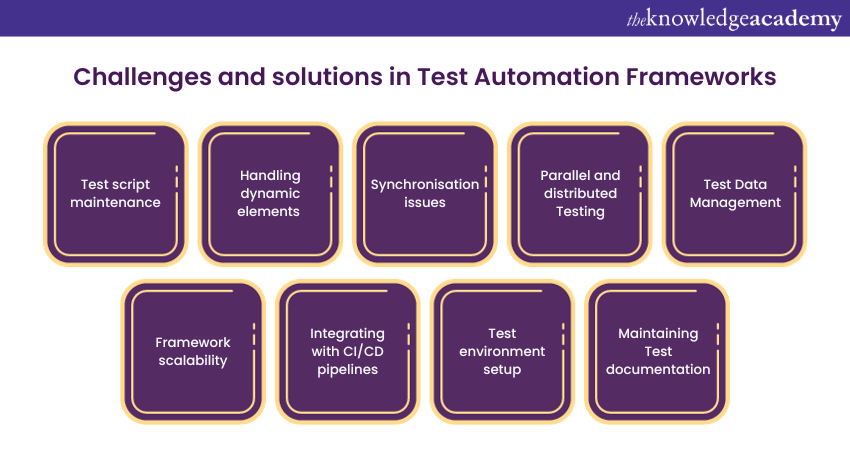
Test script maintenance
Test scripts require regular maintenance to adapt to application functionality or User Interface changes. Possible solutions can be as follows:
a) Modular design: Structure Test scripts modularly, ensuring that changes in one module don't affect others.
b) Regular reviews: Schedule regular reviews of Test scripts to identify and update obsolete or inaccurate Test cases.
c) Version control: Utilise Version Control systems to track changes and facilitate collaboration among team members.
d) Automated Testing tools: Choose tools with robust maintenance features, such as visual-based Testing or self-healing capabilities.
Handling dynamic elements
Web applications often contain dynamic elements like IDs, classes, or attributes that change frequently, causing Test failures. Possible solutions can be as follows:
a) Use stable locators: Use stable locators like XPath or CSS selectors that are less likely to change.
b) Implement waits: Introduce appropriate waits to allow dynamic elements to load before interacting with them.
c) Page object model: Employ the Page object model to encapsulate element locators and interactions, making updates centralised and easier to manage.
Synchronisation issues
Synchronisation issues occur when Test scripts execute actions before the application is ready, resulting in Test failures. Possible solutions can be as follows:
a) Explicit waits: Implement explicit waits to pause execution until specific conditions are met (e.g., element visibility, text presence).
b) Implicit waits: Set implicit waits globally to give the application extra time to load elements before interactions.
c) Custom wait methods: Create custom wait methods that handle specific synchronisation scenarios, enhancing reliability.
Parallel and distributed Testing
Parallel testing, where multiple Test cases execute simultaneously, can lead to resource contention and synchronisation issues. Possible solutions can be as follows:
a) Resource management: Use resource management tools to allocate resources efficiently among parallel Test cases.
b) Shared state handling: Implement mechanisms to manage shared data or resources to avoid conflicts and data corruption.
Test Data Management
Managing Test data, especially for data-driven Testing, can become complex and error-prone. Possible solutions can be as follows:
a) Data storage: Store Test data separately from Test scripts in external files or databases for easy updates.
b) Data generators: Use data generators to create Test data programmatically, enhancing data diversity and coverage.
c) Data masking: When dealing with sensitive data, implement data masking techniques to ensure data privacy.
Framework scalability
As the application grows, the framework may need help accommodating more Test cases and scenarios. Possible solutions can be as follows:
a) Modular architecture: Design the framework with a modular architecture that easily supports adding or removing modules.
b) Parallel execution: Implement parallel execution capabilities to efficiently distribute Test cases across available resources.
c) Scalable Data management: Opt for scalable data storage solutions like databases or cloud services to handle increasing data requirements.
Integrating with CI/CD pipelines
Integrating the framework with CI/CD pipelines for continuous Testing can be complex. Possible solutions can be as follows:
a) Automated triggers: Set up automated triggers that initiate Test execution upon code commits or deployments.
b) Configuration management: Maintain a clear separation between Test scripts and configuration settings to facilitate pipeline integration.
Test environment setup
Configuring and maintaining Test environments that mirror production can be challenging. Possible solutions can be as follows:
a) Infrastructure as code: Use infrastructure automation tools to define and provision Test environments consistently.
b) Containerisation: Employ containerisation technologies like Docker to create portable and reproducible Test environments.
Maintaining Test documentation
Documentation of test cases and framework components often needs to catch up, leading to confusion and inefficiencies. Possible solutions can be as follows:
a) Automated documentation: Generate documentation from annotations in Test scripts or use tools that auto-generate documentation.
b) Regular updates: Incorporate documentation updates as part of the regular maintenance process.
Which Testing Framework is the best?
Given the vast Testing Frameworks available, determining the most suitable one can take time. To identify the optimal solution, it is imperative to begin by comprehending your specific requirements.
For those who employ coding in their Testing process, opt for a flexible framework. You should search for a framework that accommodates various programming languages and application types, such as Selenium. If your Testing approach is codeless, you may also choose to operate without the need for coding, like Testim. It is equally important to consider your budget and the compatibility of the framework with your chosen platform before making a final decision.
Conclusion
A well-structured Test Automation Framework is the cornerstone of efficient and reliable Software Testing. Organisations can enhance Testing quality and accelerate development cycles. As a result, they can achieve successful software delivery by addressing challenges, leveraging best practices, and selecting the right framework type.
Learn about the features of automation and the benefits of Selenium WebDrive; sign up for our Introduction To Test Automation With Selenium Web Driver Course now!
Frequently Asked Questions
Upcoming Advanced Technology Resources Batches & Dates
Date
 Fundamentals of Test Automation
Fundamentals of Test Automation
Fri 26th Jul 2024
Fri 22nd Nov 2024







 Top Rated Course
Top Rated Course


 If you wish to make any changes to your course, please
If you wish to make any changes to your course, please


